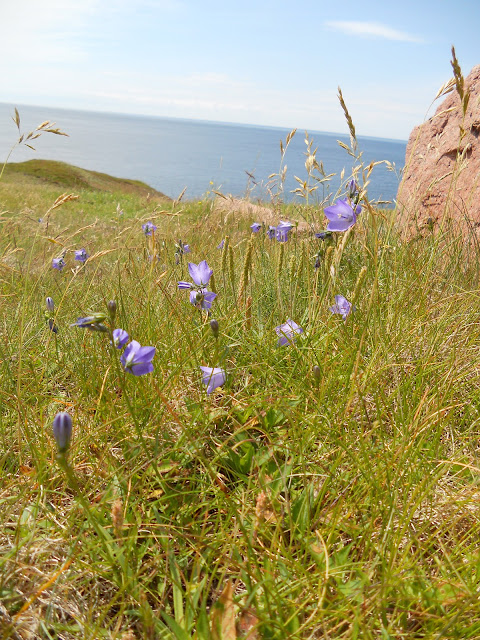I have been off the blog wagon, but for good reason! Noah and I got married on June 23rd and then spent two weeks on Cape Breton Island in Nova Scotia. It was one of the most beautiful places I have ever been and one of the quietest. We were lent a house near Cape North, at the very northern tip of the island, and the house was a half mile from the above beach (Cabot's Landing). In the 10 days or so we were there, we only saw about 18 people. It was a beautiful and lonely place, wild, dramatic, and remote. It was a perfect place for two very social people to spend their honeymoon.
A rocky beach a short walk from the house. The house was on Asbey Bay and the water was shallow and warm, perfect for swimming. We were told there were places to collect oysters, but we never made it there. There were lots of beautiful coastal plants growing here.
Such as this lovely Artemesia stelleriana. This is our common Dusty Miller Artemisia, also known as beach wormwood, but when I saw it growing in the wild it seemed to unusual and so beautiful. It reminded me of Artemisia stelleriana 'Silver Broacde,' but I didn't actually think they were the same species. I think this plant is originally from Japan, but it has naturalized on the east coast of North America. This plant loves great drainage (it grows in rocks) and salty, misty air.
Another fascinating plant growing in luscious clumps out of rocks and sand, this is Seabeach Sandwort, or Honckenya peploides (syn. Arenaria peploides). I admired this plant immediately for its bright green, waxy foliage and its succulent, creeping, yet upright habit. This also happens to be a monotypic genus, which always appeals to me for some reason. I guess I love the individuality of a genus with one species.
One day we took a hike from Meat Cove to the Cape of St. Lawrence. We had to trek over a small, coastal mountain to get out to the wild and remote cape. Along the way there was a hillside of dripping moss covered in little blossoms of Oxalis montana.
The Cape of St. Lawrence, with clear blue water full of man-of-war jelly fish. Out on the horizon we saw thousands of blue- billed Gannets dive- bombing from great heights into the sea to catch their fish.
As we came down the hill and out of the woods there was this long headland covered in grass and other wild plants- it was wide open and beautiful. There were two different crumbling foundations where old lighthouses once stood. Today there is a small, solar powered light tower that takes the place of the old lighthouses. In amongst the beautiful granite foundation rocks are hundreds of Campanula rotundifolia swaying in the strong winds. This is a classic alpine/coastal plant- it can take blazing sun, drought, wind, free draining, rocky soil, extreme cold, and in this case salty sea spray. What a plant!
Thalictrum pubescens growing at the boggy edges. There were fields of this plant in full bloom.
View from the top of Sugarloaf Mountain looking down on Cabot's Landing beach.










Glad you enjoyed your stay! Come again!
ReplyDeleteWow! Great photos. First and last make we want to head to the beach. Congrats Helen.
ReplyDeleteCongratulations Helen & Noah! What a beautiful place to spend your honeymoon. May you enjoy your next ten years together as much as my husband and I have enjoyed our last ten years! Being married can be challenging, but it is the good kind.
ReplyDelete~Julie
Thanks Julie and Paula!
ReplyDelete